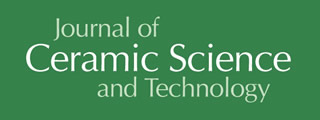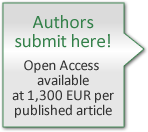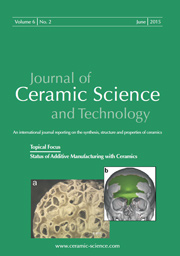Articles
All articles | Recent articles
Integration of Piezoceramic Composites into Structural Components: Effect on the Polarisation State and Polarisability
K. Hohlfeld1, S. Eßlinger2, A. Eydam3, A. Winkler4, T. Weber4, M. Gude4, N. Modler4, G. Gerlach3, G. Suchaneck3, A. Michaelis1,2, A. Schönecker2, S. Gebhardt2, P. Neumeister2
1 Technische Universität Dresden (TUD), Institute of Materials Science (IfWW), D-01062 Dresden, Germany
2 Fraunhofer Institute for Ceramic Technologies and Systems (IKTS), Winterbergstraße 28, D-01277 Dresden, Germany
3 Technische Universität Dresden (TUD), Solid State Electronics Laboratory (IFE), D-01062 Dresden, Germany
4 Technische Universität Dresden (TUD), Institute of Lightweight Engineering and Polymer Technology (ILK), D-01062 Dresden, Germany
received June 26, 2018, received in revised form February 3, 2019, accepted February 18, 2019
Vol. 10, No. 1, Pages 19-26 DOI: 10.4416/JCST2018-00071
Abstract
In lightweight construction, structural components with integrated piezoelectric sensors and actuators find application for condition monitoring, structural health monitoring, vibrational control, and reduction of noise emission. In order to create such multifunctional, so-called smart components, an integration technique for serial production, designed for embedding of piezofibre composites into thermoplastic structures, was developed recently. During the two-stage fabrication process, thermal and mechanical loads act on the piezoceramic, which can lead to partial depolarisation and thus degradation of the piezoelectric properties. Since the mechanical boundary conditions are significantly differing between the manufacturing stages, a direct determination and subsequent comparison of the piezoelectric values appears very difficult. Therefore, the effect of each process step of integration (here called integration step) on the polarisation state and polarisability of the piezofibre composites was investigated directly. The results indicate distinctive effects depending on the particular integration step. For the investigated integration technique, the overall depolarisation remains in a range which seems acceptable for low power applications such as sensing. However, for actuation the results suggest re-poling or poling after integration to assure maximum piezoelectric performance.
![]() Download Full Article (PDF)
Download Full Article (PDF)
Keywords
Piezofibre composite, Integration, Polarisation state, Polarisability
References
1 Hufenbach, W., Modler, N., Winkler, A., Ilg, J., Rupitsch, S. J.: Fibre-reinforced composite structures based on thermoplastic matrices with embedded piezoceramic modules, Smart Mater. Struct., 23, 025011, (2014).
2 Hufenbach, W., Gude, M., Modler, N., Heber, Th., Winkler, A., Weber, T.: Process chain modeling and analysis for the high-volume production of thermoplastic composites with embedded piezoceramic modules, Smart Mater. Res., 2013, 201631, (2013).
3 Hohlfeld, K., Neumeister, P., Michaelis, A., Gebhardt, S.: Tailored composite transducers based on piezoceramic fibers and pearls, In: Proceedings ACTUATOR 2016, June 13 – 15, Bremen, 69 – 72, 2016.
4 Damjanovic, D.: Stress and frequency dependence of the direct piezoelectric effect in ferroelectric ceramics, J. Appl. Phys., 82, 1788 – 1797, (1997).
5 Yang, G., Mukherjee, B. K.: The stress dependence of the piezoelectric d coefficient of piezoelectric and electrostrictive ceramic materials, J. Acoust. Soc. Am., 106, 2122, (1999).
6 Zhao, J., Glazounov, A. E., Zhang, Q. M.: Change in electromechanical properties of 0.9PMN:0.1PT relaxor ferroelectric induced by uniaxial compressive stress directed perpendicular to the electric field, Appl. Phys. Lett., 74, 436 – 438, (1999).
7 Fan, J., Stoll, W. A., Lynch, C. S.: Nonlinear constitutive behavior of soft and hard PZT: Experiments and modeling, Acta Mater., 47, 4415 – 4425, (1999).
8 Chaplya, P. M., Carman, G. P.: Dielectric and piezoelectric response of lead zirconate-lead titanate at high electric and mechanical loads in terms of non-180° domain wall motion, J. Appl. Phys., 90, 5278, (2001).
9 Mauck, L. D., Lynch, C. S.: Thermo-electro-mechanical behavior of ferroelectric materials, Part I: A computational micromechanical model versus experimental results, J. Intel. Mater. Sys. Struct., 14, pp. 587 – 602, (2003).
10 Zhou, D., Kamlah, M., Munz, D.: Effects of uniaxial prestress on the ferroelectric hysteretic response of soft PZT, J. Eur. Ceram. Soc., 25 (4), 425 – 432, (2005).
11 Nicolai, M.: (Poling behaviour of piezoceramics under combined electrical, mechanical, and thermal stress) Polarisierungsverhalten von Piezokeramik unter kombinierter elektrischer, mechanischer und thermischer Beanspruchung, (Phd thesis) Dissertation Technische Universität Dresden, Dresden, 2012.
12 Neumeister, P., Eßlinger, S., Gebhardt, S., Schönecker, A., Flössel, M.: Effect of mechanical constraints in thin ceramic LTCC/PZT multilayers on the polarization behavior of the embedded PZT, Int. J. Appl. Ceram. Technol., 11, 422 – 430, (2014).
13 Winkler, A.: (Series-compatible design and manufacturing techniques of functional integrated thermoplastic fiber-reinforced plastic parts with embedded piezoceramic modules) Seriengerechte Bauweisen und Fertigungstechnologien für funktionsintegrative thermoplastische Faserverbundbauteile mit eingebetteten Piezokeramik-Modulen, Dissertation (Phd thesis), Technische Universität Dresden, Dresden, (2016).
14 Hohlfeld, K. et al.: Effect of the integration of piezoceramic composites into structural components on their poling condition and polarizability, In: VIII ECCOMAS Thematic Conference on Smart Structures and Materials SMART 2017, 5 – 8 June 2017, Madrid, Spain, Eds. A. Güemes, A. Benjeddou, J. Rodellar and J. Leng. Barcelona: International center for numerical methods in engineering (CIMNE): 349 – 358, 2017, ISBN: 978 – 84 – 946909 – 3-8.
15 Lang, S.B., Das-Gupta, D.K.: Laser-intensity-modulation method: a technique for determination of spatial distributions of polarization and space charge in polymer electrets, J. Appl. Phys., 59, 2151-2160, (1986).
16 Ploss, B., Emmerich, R., Bauer, S.: Thermal wave probing of pyroelectric distributions in the surface region of ferroelectric materials: a new method for the analysis, J. Appl.Phys., 72, 5363-5370, (1992).
17 Eydam, A., Suchaneck, G., Hohlfeld, K., Gebhardt, S., Michaelis, A., Gerlach, G.: Evaluation of the polarization state of piezofiber composites, In: Proceedings IEEE Joint ISAF-PFM 2013, 190 – 193, Prag, Czech Republic, 2013.
18 Hohlfeld, K., Gebhardt, S., Schönecker, A., Michaelis, A.: PZT components derived from polysulphone spinning process, Adv. Appl. Ceram., 114, 231 – 237, (2015).
19 Heber, Th., Gude, M., Hufenbach, W.: Production process adapted design of thermoplasticcompatible piezoceramic modules, Composites: Part A. 59, 70 – 77, (2014).
20 Bauer, S., Ploss, B.: A method for the measurement of the thermal, dielectric, and pyroelectric properties of thin pyroelectric films and their applications for integrated heat sensors, J. Appl. Phys., 68, 6361 – 6367, (1990).
21 Carslaw, H. S., Jaeger, J. C.: Conduction of heat in solids, 2nd ed., New York, NY: Oxford University Press, (1959).
22 Eydam, A., Suchaneck, G., Eßlinger, S., Schönecker, A., Neumeister, P., Gerlach, G.: Polarization characterization of PZT disks and of embedded PZT plates by thermal wave methods, In: AIP Conf. Proceedings 1627, 31 – 36, (2014).
23 Suchaneck, G., Eydam, A., Hu, W., Krantz, B., Drossel, W.-G., Gerlach, G.: Evaluation of polarization of embedded piezoelectrics by the thermal wave method, IEEE Tran. Ultrason. Ferroelectr. Freq. Control, 59, 1950 – 1954, (2012).
24 Suchaneck, G., Eydam, A., Rübner, M., Schwankl, M., Gerlach, G.: A simple thermal wave method for the evaluation of the polarization state of embedded piezoceramics, Ceram. Int., 39, 587 – 590, (2013).
25 Eydam, A., Suchaneck, G., Schwankl, M., Gerlach, G., Singer, R. F., Körner, C.: Evaluation of polarization state of light metal embedded piezoelectrics, Advances in Applied ceramics 114, 226 – 230, (2015).
26 Bauer, S., Bauer-Gogonea, S.: Current practice in space charge and polarization profile measurements using thermal techniques, IEEE Trans. Diel. Electr. Insul. 10, 883 – 902, (2003).
27 Liu, S. T., Zook, J. D.: Evaluation of curie constants of ferroelectric crystals from pyroelectric response, Ferroelectrics 7, 171 – 173, (1974).
28 Eydam, A., Suchaneck, G., Gerlach, G.: Non-destructive evaluation of integrated piezoelectric transducers by thermal waves and thermal pulses, In: 3rd International Conference on System-Integrated Intelligence: New Challenges for Product and Production Engineering 2016, Proceedia Technology, 26, 59 – 65, 2016.
29 Sawyer, C. B., Tower, C. H.: Rochelle salt as a dielectric, Phys. Rev., 35, 269 – 275, (1930).
30 CeramTec Datasheet 'Materials for actuators', SONOX® P505, CeramTec GmbH, Lauf, Germany, (2017).
Copyright
Göller Verlag GmbH


